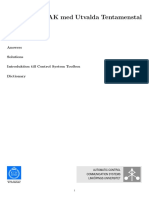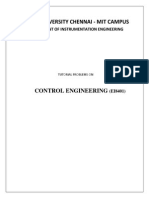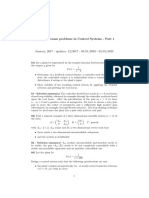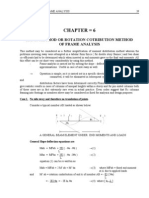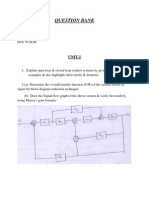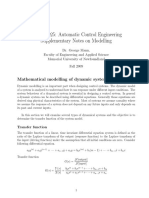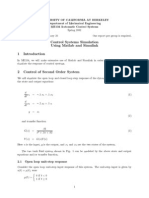Control Systems 2
Uploaded by
Sengottu VelusamyControl Systems 2
Uploaded by
Sengottu VelusamyDEPARTMENT OF INSTRUMENTATION ENGINEERING
MIT CAMPUS-ANNA UNIVERSITY CHENNAI.
TUTORIAL PROBLEMS ON
CONTROL ENGINEERING (EI8401)
ASSESMENT-1
1.Find the Transfer function
a) Y
2
(s)/R
1
(s) and
b) Y
2
(s)/R
2
(s) using Block diagram reduction technique.
Solution:
a) Y
2
(s)/R
1
(s)
Hence Y
2
(s)/R
1
(s) = 3/ (s
2
+2s+3)
b) Y
2
(s)/R
2
(s)
Hence Y
2
(s)/R
2
(s) = (-s-2)/ (s
2
+2s+3)
2. Construct Signal Flow Graph for the Differential equation given below.
Solution:
Step 1: Solve the above equation for highest order
Step 2: Consider the left hand terms(highest derivative) as dependant variable
and all other terms on right hand side as independent variables.
Construct the branches of Signal flow graph as shown below:
(a)
Step 3: Connect the nodes of highest order derivatives to the lowest order node
and so on. The flow of signal will be from higher node to lower node and
transmittance will be 1/s as shown in fig (b)
(b)
x y y y y = + ' + ' ' + ' ' ' 2 5 3
y y y x y 2 5 3 ' ' ' = ' ' '
Step 4: Reverse the sign of a branch connecting y to y, with condition no
change in T/F fn.
Step5: Redraw the SFG as shown.
3.For the following state space model of a system, Comment on
Controllability and Observability of the system.
SOLUTION:
i) Controllabilty Matrix, U= [B AB] = [ 3 -6
1 -1 ]
Here rank(U) = 2 = Order of the Matrix
Hence the System is Completely State Controllable.
ii) Observability Matrix, V=[C
CA ]
=[1 0
-2 0 ]
Here rank(U) = 1 Order of the Matrix
Hence the System is NOT Observable.
| |
(
=
(
+
(
=
(
2
1
2
1
2
1
0 1
) (
1
3
1 0
0 2
x
x
y
t u
x
x
x
x
ASSESMENT-2:
1.Obtain the state transition matrix u(t) of the following system. Obtain
also the inverse of the state transition matrix u
-1
(t) .
SOLUTION:
For this system,
The state transition matrix u(t) is given by,
Now,
The inverse (sI-A) is given by,
By Taking Inverse Laplace Transform,
State Transition Matrix is given by,
Since u
-1
(t)= u(-t), we obtain the inverse of transition matrix as,
2.The Transfer function of the system is given as follows. When the system
oscillates with a frequency of oscillation 2 rad/sec, find K and a.
SOLUTION:
The Characteristic equation is given by
1+G(s)H(s) = k(s+1)/ (s
3
+bs
2
+3s+1) + 1 = 0
s
3
+bs
2
+3s+1+k(s+1)=0
s
3
+bs
2
+(3+k)s+(k+1)=0
For Marginally Stable system,
The condition is b(3+k) = (k+1)
b = (k+1) / (k+3)
Now Auxiliary Equation is given by
bs
2
+(k+1)=0
When s=jw
b(-w
2
) + (k+1) = 0
Given w=2 rad/sec,
b(-4) + (k+1) = 0
Substitute the value of b from above equation,
And Solving for k, we get,
K=1
Now b is found as b=0.5
3. A control System defined as follows:
d
2
x/dt
2
+ 6 dx/dt + 5x = 12(1-e
-2t
). Find Response at t tends to
SOLUTION:
Taking Laplace Transform of given equation,
s
2
X(s) + 6 sX(s) + 5 X(s) = 12(1/s 1/s+2)
X(s)[ s
2
+6s+5] = 12(1/s 1/s+2)
On solving for X(s), we get,
X(s)= 24/ s(s+2)( s
2
+6s+5)
By Final value Theorem,
Now x(t) when t tends to = lim s tends to 0 [sX(s)]
= 24/ (2* 5) = 2.4
ASSESMENT-3
1.Sketch the bode plot for the Transfer Function,
SOLUTION:
Step 1: Convert the TF in following standard form & put s=jw
Step 2: Find out corner frequencies
,
So corner frequencies are 10, 1000 rad/sec
The slope will change at each corner frequency by +20dB/dec for zero and
-20dB/dec for pole.
Step 3:
Term Corner Frequency
rad/sec
Slope db/dec Change in slope
db/dec
1/(1+0.1jw)
W
c1
= 10
-20
0-20=-20
1/(1+0.001jw)
W
c2
= 1000
-20
-20-20=-40
) 001 . 0 1 )( 1 . 0 1 (
1000
) (
s s
s G
+ +
=
) 001 . 0 1 )( 1 . 0 1 (
1000
) (
jw jw
jw G
+ +
=
10
1 . 0
1
= 1000
001 . 0
1
=
MAGNITUDE PLOT:
PHASE PLOT:
S.No W Angle (G(jw)
1 1 ----
2 100 -90
0
3 200 -98
0
4 1000 -134.42
0
5 2000 -153.15
0
6 3000 -161.36
0
7 5000 -168.57
0
8 8000 -172.79
0
9 Infi -180
0
PHASE PLOT:
COMPLETE BODE PLOT:
2.The open loop Transfer function of a Unity Negative feedback Control system is
given by
G(s) =
Find the Phase Cross over frequency and Gain Margin.
SOLUTION:
i) Phase Cross over frequency can be found by equating the Phase
angle of G(s) to -180 degree.
-90 -
= -180
On Sloving for w, we get,
Phase Cross over frequency, W
pc
=15 rad/sec.
ii) Gain Margin is found by
G.M = 20 log (
)
Hence, G.M= 20 log (
) dB
Since W= 15 rad/sec,
Substituting in the above equation, we get,
Gain Margin, G.M= 34.15 dB.
3.Design cascade Lead compensator for the following system
G(s) =
for >=30, W
c
>=45 rad/sec,
K
v
>=100s
-1
.
SOLUTION:
Step 1: Determine desired gain K.
Step 2: Gain-compensated system analysis
Let W
c
=50 > 45 rad/sec, then
Arg G
P
(j50) = -90- arctan5-arctan0.5
= -90-78.69- 26.57
= -195.26
The bode diagram for the compensator is given below.
Bode Diagram for the Compensator:
Step 3: Required phase lead angle
Step 4: Calculate
Step 5: Calculate T
Take
Then,
Step 6: Compensator is designed as,
Step 7: Final check
By Asymptotes
o
10
sin 1
sin 1
=
+
=
m
m
o
s rad
m
/ 50 = =
8 . 15
1
158
1
50
1
= = =
T T
T
o
o
s
s
s
s
s G
c
006325 . 0 1
06325 . 0 1
1
158
1
1
8 . 15
1
) (
+
+
=
+
+
=
By Actual Curves
You might also like
- Refutation of - Some Observations, - by Frithjof Schuon - Criticizing René Guénon - Pages 16 To The End.No ratings yetRefutation of - Some Observations, - by Frithjof Schuon - Criticizing René Guénon - Pages 16 To The End.42 pages
- The Dodges and Their Potteries - Maine Antique Digest February 2018100% (1)The Dodges and Their Potteries - Maine Antique Digest February 20183 pages
- Geng4402 - Assignment 2: Question 1 - Nyquist Plot/Frequency Response PerformanceNo ratings yetGeng4402 - Assignment 2: Question 1 - Nyquist Plot/Frequency Response Performance9 pages
- Some Past Exam Problems in Control Systems - Part 1No ratings yetSome Past Exam Problems in Control Systems - Part 15 pages
- Mcqs On Control Systems: Page 22 of 23. Go To PageNo ratings yetMcqs On Control Systems: Page 22 of 23. Go To Page4 pages
- Mathematical Modeling of Mechanical Systems and Electrical SystemsNo ratings yetMathematical Modeling of Mechanical Systems and Electrical Systems49 pages
- Handout E.15 - Examples On Transient Response of First and Second Order Systems, System Damping and Natural FrequencyNo ratings yetHandout E.15 - Examples On Transient Response of First and Second Order Systems, System Damping and Natural Frequency14 pages
- Sample Solution To Exam in MAS501 Control Systems 2 Autumn 2015No ratings yetSample Solution To Exam in MAS501 Control Systems 2 Autumn 20158 pages
- Control System MCQ (Multiple Choice Questions) - JavatpointNo ratings yetControl System MCQ (Multiple Choice Questions) - Javatpoint51 pages
- EE 4343/5329 - Control System Design Project: EE 4343/5329 Homepage EE 4343/5329 Course OutlineNo ratings yetEE 4343/5329 - Control System Design Project: EE 4343/5329 Homepage EE 4343/5329 Course Outline14 pages
- Modeling in The Frequency Domain: Prof. Ju-Jang LeeNo ratings yetModeling in The Frequency Domain: Prof. Ju-Jang Lee32 pages
- ME 360 Control Systems PID Control of A Spring-Mass-Damper (SMD) PositionNo ratings yetME 360 Control Systems PID Control of A Spring-Mass-Damper (SMD) Position7 pages
- Elec/Tele/Phtn 4123 Electrical/Telecommunications Design Proficiency Lab2No ratings yetElec/Tele/Phtn 4123 Electrical/Telecommunications Design Proficiency Lab211 pages
- EE-EC - RIB (W) - Control Sys - 13-08-16 - SK1-sol - 1391No ratings yetEE-EC - RIB (W) - Control Sys - 13-08-16 - SK1-sol - 13919 pages
- ENGR 6925: Automatic Control Engineering Supplementary Notes On ModellingNo ratings yetENGR 6925: Automatic Control Engineering Supplementary Notes On Modelling31 pages
- Note 5 Time Response: Lecture Notes of Control Systems I - ME 431/analysis and Synthesis of Linear Control System - ME862No ratings yetNote 5 Time Response: Lecture Notes of Control Systems I - ME 431/analysis and Synthesis of Linear Control System - ME86210 pages
- Phase Lead Compensator Design Project Mauricio Oñoro: Figure 1 Circuit To Be ControlledNo ratings yetPhase Lead Compensator Design Project Mauricio Oñoro: Figure 1 Circuit To Be Controlled8 pages
- 1-01-c Transfer Function and System Block DiagramNo ratings yet1-01-c Transfer Function and System Block Diagram14 pages
- Exercise#1:: (A) Find The Step Response of The Following Transfer FunctionNo ratings yetExercise#1:: (A) Find The Step Response of The Following Transfer Function13 pages
- Matlab, Simulink - Control Systems Simulation Using Matlab and SimulinkNo ratings yetMatlab, Simulink - Control Systems Simulation Using Matlab and Simulink10 pages
- Identification: 2.1 Identification of Transfer Functions 2.1.1 Review of Transfer FunctionNo ratings yetIdentification: 2.1 Identification of Transfer Functions 2.1.1 Review of Transfer Function29 pages
- A Simple Control Arithmetic of Step Wave Cascaded Multilevel Inverter With Different Voltage StepNo ratings yetA Simple Control Arithmetic of Step Wave Cascaded Multilevel Inverter With Different Voltage Step5 pages
- Design of The Deadbeat Controller With Limited Output: L. Balasevicius, G. DervinisNo ratings yetDesign of The Deadbeat Controller With Limited Output: L. Balasevicius, G. Dervinis4 pages
- Student Solutions Manual to Accompany Economic Dynamics in Discrete Time, secondeditionFrom EverandStudent Solutions Manual to Accompany Economic Dynamics in Discrete Time, secondedition4.5/5 (2)
- Fundamentals of Electronics 3: Discrete-time Signals and Systems, and Quantized Level SystemsFrom EverandFundamentals of Electronics 3: Discrete-time Signals and Systems, and Quantized Level SystemsNo ratings yet
- Control Tutorials For MATLAB and Simulink - Introduction - PID Controller DesignNo ratings yetControl Tutorials For MATLAB and Simulink - Introduction - PID Controller Design15 pages
- Control Tutorials For MATLAB and Simulink - Introduction - PID Controller DesignNo ratings yetControl Tutorials For MATLAB and Simulink - Introduction - PID Controller Design15 pages
- Badri Engineering Corporation: One Stop Shop For All Your Industrial NeedsNo ratings yetBadri Engineering Corporation: One Stop Shop For All Your Industrial Needs2 pages
- Manual of Pesticide Residue Analysis Volume II PDFNo ratings yetManual of Pesticide Residue Analysis Volume II PDF493 pages
- SDET Bottles Filling and Capping Machine Operation ManualNo ratings yetSDET Bottles Filling and Capping Machine Operation Manual10 pages
- Influence: Science and Practice by Robert CialdiniNo ratings yetInfluence: Science and Practice by Robert Cialdini12 pages
- Shutdown Ipcs in The Sitop Psu8600 Buffer ModeNo ratings yetShutdown Ipcs in The Sitop Psu8600 Buffer Mode37 pages
- Barnardos Domestic Violence Risk Identification Matrix-2No ratings yetBarnardos Domestic Violence Risk Identification Matrix-21 page
- Refutation of - Some Observations, - by Frithjof Schuon - Criticizing René Guénon - Pages 16 To The End.Refutation of - Some Observations, - by Frithjof Schuon - Criticizing René Guénon - Pages 16 To The End.
- The Dodges and Their Potteries - Maine Antique Digest February 2018The Dodges and Their Potteries - Maine Antique Digest February 2018
- Geng4402 - Assignment 2: Question 1 - Nyquist Plot/Frequency Response PerformanceGeng4402 - Assignment 2: Question 1 - Nyquist Plot/Frequency Response Performance
- Some Past Exam Problems in Control Systems - Part 1Some Past Exam Problems in Control Systems - Part 1
- Mcqs On Control Systems: Page 22 of 23. Go To PageMcqs On Control Systems: Page 22 of 23. Go To Page
- Mathematical Modeling of Mechanical Systems and Electrical SystemsMathematical Modeling of Mechanical Systems and Electrical Systems
- Handout E.15 - Examples On Transient Response of First and Second Order Systems, System Damping and Natural FrequencyHandout E.15 - Examples On Transient Response of First and Second Order Systems, System Damping and Natural Frequency
- Sample Solution To Exam in MAS501 Control Systems 2 Autumn 2015Sample Solution To Exam in MAS501 Control Systems 2 Autumn 2015
- Control System MCQ (Multiple Choice Questions) - JavatpointControl System MCQ (Multiple Choice Questions) - Javatpoint
- EE 4343/5329 - Control System Design Project: EE 4343/5329 Homepage EE 4343/5329 Course OutlineEE 4343/5329 - Control System Design Project: EE 4343/5329 Homepage EE 4343/5329 Course Outline
- Modeling in The Frequency Domain: Prof. Ju-Jang LeeModeling in The Frequency Domain: Prof. Ju-Jang Lee
- ME 360 Control Systems PID Control of A Spring-Mass-Damper (SMD) PositionME 360 Control Systems PID Control of A Spring-Mass-Damper (SMD) Position
- Elec/Tele/Phtn 4123 Electrical/Telecommunications Design Proficiency Lab2Elec/Tele/Phtn 4123 Electrical/Telecommunications Design Proficiency Lab2
- EE-EC - RIB (W) - Control Sys - 13-08-16 - SK1-sol - 1391EE-EC - RIB (W) - Control Sys - 13-08-16 - SK1-sol - 1391
- ENGR 6925: Automatic Control Engineering Supplementary Notes On ModellingENGR 6925: Automatic Control Engineering Supplementary Notes On Modelling
- Note 5 Time Response: Lecture Notes of Control Systems I - ME 431/analysis and Synthesis of Linear Control System - ME862Note 5 Time Response: Lecture Notes of Control Systems I - ME 431/analysis and Synthesis of Linear Control System - ME862
- Phase Lead Compensator Design Project Mauricio Oñoro: Figure 1 Circuit To Be ControlledPhase Lead Compensator Design Project Mauricio Oñoro: Figure 1 Circuit To Be Controlled
- Exercise#1:: (A) Find The Step Response of The Following Transfer FunctionExercise#1:: (A) Find The Step Response of The Following Transfer Function
- Matlab, Simulink - Control Systems Simulation Using Matlab and SimulinkMatlab, Simulink - Control Systems Simulation Using Matlab and Simulink
- Identification: 2.1 Identification of Transfer Functions 2.1.1 Review of Transfer FunctionIdentification: 2.1 Identification of Transfer Functions 2.1.1 Review of Transfer Function
- A Simple Control Arithmetic of Step Wave Cascaded Multilevel Inverter With Different Voltage StepA Simple Control Arithmetic of Step Wave Cascaded Multilevel Inverter With Different Voltage Step
- Design of The Deadbeat Controller With Limited Output: L. Balasevicius, G. DervinisDesign of The Deadbeat Controller With Limited Output: L. Balasevicius, G. Dervinis
- Student Solutions Manual to Accompany Economic Dynamics in Discrete Time, secondeditionFrom EverandStudent Solutions Manual to Accompany Economic Dynamics in Discrete Time, secondedition
- Shortcuts to College Calculus Refreshment KitFrom EverandShortcuts to College Calculus Refreshment Kit
- Fundamentals of Electronics 3: Discrete-time Signals and Systems, and Quantized Level SystemsFrom EverandFundamentals of Electronics 3: Discrete-time Signals and Systems, and Quantized Level Systems
- Exercises of Line, Surface and Volume IntegralsFrom EverandExercises of Line, Surface and Volume Integrals
- Control Tutorials For MATLAB and Simulink - Introduction - PID Controller DesignControl Tutorials For MATLAB and Simulink - Introduction - PID Controller Design
- Control Tutorials For MATLAB and Simulink - Introduction - PID Controller DesignControl Tutorials For MATLAB and Simulink - Introduction - PID Controller Design
- Badri Engineering Corporation: One Stop Shop For All Your Industrial NeedsBadri Engineering Corporation: One Stop Shop For All Your Industrial Needs
- Manual of Pesticide Residue Analysis Volume II PDFManual of Pesticide Residue Analysis Volume II PDF
- SDET Bottles Filling and Capping Machine Operation ManualSDET Bottles Filling and Capping Machine Operation Manual
- Influence: Science and Practice by Robert CialdiniInfluence: Science and Practice by Robert Cialdini
- Barnardos Domestic Violence Risk Identification Matrix-2Barnardos Domestic Violence Risk Identification Matrix-2


